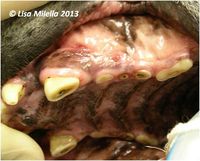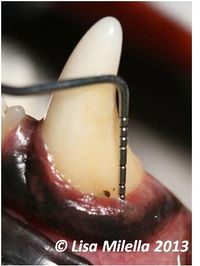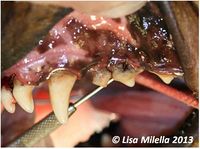Dental Indices and Criteria
Introduction

The following indices and criteria should be evaluated for each tooth:
- Gingivitis and gingival index
- Periodontal probing depth
- Gingival recession
- Furcation involvement
- Mobility
In animals with large accumulations of dental deposits (plaque and calculus) on the teeth, it may be necessary to remove these to assess periodontal status accurately. Care must be taken not to damage the gingival tissues whilst removing the calculus.
Gingivitis and Gingival Index
The presence and degree of gingivitis (inflammation of the gingiva) is assessed based on a combination of redness and swelling, as well as presence or absence of bleeding on gentle probing of the gingival sulcus. An index which relies on both visual inspection and bleeding, namely the modified Löe and Silness gingival index (Löe, 1967), can also be used:
- Gingival index 0 - Clinically healthy gingiva
- Gingival index 1 - Mild gingivitis: slight reddening and swelling of the gingival margin; no bleeding on gentle probing of the gingival sulcus
- Gingival index 2 - Moderate gingivitis: the gingival margin is red and swollen; gentle probing of the gingival sulcus results in bleeding
- Gingival index 3 - Severe gingivitis: the gingival margin is very swollen with a red or bluish-red color; there is spontaneous hemorrhage and/or ulceration of the gingival margin
Periodontal Probing Depth (PPD)
The depth of the sulcus can be assessed by gently inserting a graduated periodontal probe until resistance is encountered at the base of the sulcus. The depth from the free gingival margin to the base of the sulcus is measured in mm at several locations around the whole circumference of the tooth. The probe is moved gently horizontally, walking along the floor of the sulcus. The gingival sulcus is normally 1–3 mm deep in the dog and 0.5–1 mm in the cat. Measurements in excess of these values usually indicate periodontal disease, when the periodontal ligament has been destroyed and alveolar bone resorbed, thus allowing the probe to be inserted to a greater depth. The term used to describe this is periodontal pocketing. All sites with periodontal pocketing should be accurately recorded. Gingival inflammation resulting in swelling or hyperplasia of the free gingiva will, of course, also result in measuring sulcus depths in excess of normal values. In these situations, the term pseudopocketing is used, as the periodontal ligament and bone are intact (i.e.there is no evidence of periodontitis) and the increase in PPD is due to swelling or hyperplasia of the gingiva.
Gingival Recession
Gingival recession is also measured using a periodontal probe. It is the distance (in mm) from the cemento-enamel junction to the free gingival margin. At sites with gingival recession, PPD may be within normal values despite loss of alveolar bone due to periodontitis.
Furcation Involvement
Furcation involvement refers to the situation where the bone between the roots of multirooted teeth is destroyed due to periodontitis. The furcation sites of multirooted teeth should be examined with either a periodontal probe or dental explorer. Furcation involvement is graded as follows:
- Grade 0 - No furcation involvement
- Grade 1 - Initial furcation involvement: the furcation can be felt with the probe/explorer, but horizontal tissue destruction is less than 1/3 of the horizontal width of the furcation
- Grade 2 - Partial furcation involvement: it is possible to explore the furcation but the probe/explorer cannot be passed through it from buccal to palatal/lingual; horizontal tissue destruction is more than 1/3 of the horizontal width of the furcation
- Grade 3 - Total furcation involvement: the probe/explorer can be passed through the furcation from the buccal to palatal/lingual aspect of the mouth
Tooth Mobility
The extent of tooth mobility should be assessed using a suitable instrument, e.g. the blunt end of the handle of a dental mirror or probe. It should not be assessed using fingers directly, since the yield of the soft tissues of the fingers will mask the extent of tooth mobility. Tooth mobility is graded as follows:
- Grade 0 - No mobility
- Grade 1 - Horizontal movement of 1 mm or less
- Grade 2 - Horizontal movement of more than 1 mm. Note that multirooted teeth are scored more severely and a horizontal mobility in excess of 1 mm is usually considered a Grade 3 even in the absence of vertical movement.
- Grade 3 - Vertical as well as horizontal movement
Crown Abnormalities
Any surface defect of the crown needs to be identified and recorded. Surface defects are diagnosed using the explorer probe – the sharp point is run across the crown to identify any catches. Crown defects such as enamel dysplasia, fractured teeth (with or without pulp exposure), worn teeth, caries lesions or odontoclastic resorptive lesions are noted on the chart and treated appropriately.
| This article has been peer reviewed but is awaiting expert review. If you would like to help with this, please see more information about expert reviewing. |

